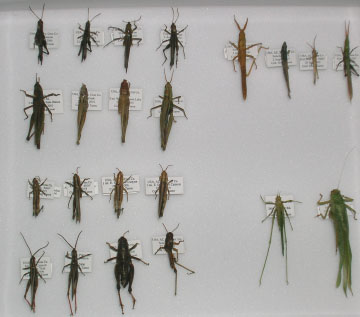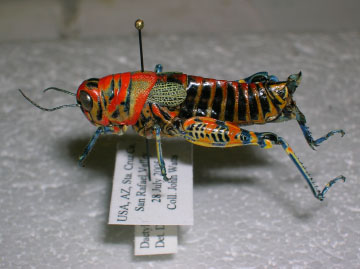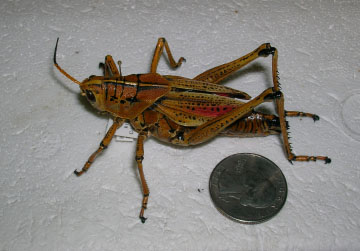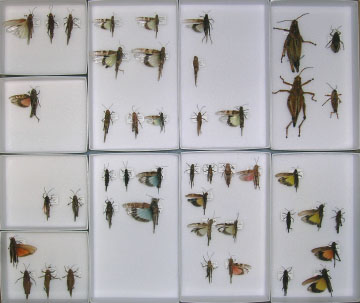Ah, Grasshopper

Like beetles, grasshoppers are a relatively recent entomological interest of mine. I’ve had at least a passing interest in grasshoppers for a bit longer than beetles, however, as grasshoppers are an important part of grassland ecosystems, including prairies. I made an unsuccessful attempt to learn how to identify them in the late 1980s. In 1998, I went to the Arizona insect conference for the first time. There I met a bunch of people who knew way more about insects than I do. None were grasshopper experts, however a couple of folks knew enough to get me started, and I was able to take it from there.

Tray of grasshoppers from my collection
Grasshoppers all belong to the same family, the Acrididae. There are around a half dozen major subfamilies in the US. One of these, the spine-breasted grasshoppers, was the main reason that I ran into trouble early. If you go out into a suburban landscape east of the Mississippi, the grasshoppers that you are most likely to encounter are really uninspiring species in the genus Melanoplus. Many of the species can only be identified by looking at the male genitalia- so if you catch a female, you’re out of luck. There are a great many species in the US. Confusing, dull, hard to identify, they’re a really bad group to try to learn first, yet they are the first group most people encounter. Of course, if you travel westward, even this group contains some really striking species like the pictured grasshopper.

Pictured grasshopper (Dactylotum bicolor)
Much more fun are some of the other subfamilies. The lubbers (Romeleinae) are big (sometimes very big) grasshopper species. As their name implies, they are kind of sluggish. Some are brightly colored, an indication that they are toxic to predators. My personal favorite is a rather chubby species called the toad lubber. They do, in fact, look rather toad-like, and they inhabit rocky areas in the desert southwest.

Eastern lubber (Romalea microptera) from Florida. These suckers are huge.

Toad lubber (Phrynotettix tshivavensis)
The slant-faced grasshoppers (Gomphocerinae) have a wider diversity of forms. Some resemble much more typical grasshoppers from other families. Others have a very long and attenuated body form, giving them the name "toothpick grasshoppers." One of these is a rare prairie species here in Illinois. A favorite from this group is Montezuma’s grasshopper (Syrbula montezumae). I like it both because it just barely gets into my favorite collecting grounds in southeast Arizona from its main range in Mexico. It’s also very pretty. Fresh specimens have beautiful turquoise markings on their legs. Unfortunately, the color fades with time, so the specimes in my collection are all now just brown.

Mermiria texana, a slant-faced grasshopper. Note the beautiful coral-red tibiae on the hind legs. I actually caught this species at night at a black light.
My favorite group is the band-winged grasshoppers (Oedipodinae). Call me shallow, but I am completely captivated by the gorgeous colors of their wings. Who knew that grasshoppers could be so beautiful? Many species have wings that are just dull yellowish, but the spectrum ranges through the reds and oranges on to a few species whose wings are a vivid blue. Even better, the colors do not fade when the specimens dry out. Some are the brightest reds and yellows are found in the genus Arphia. I don’t even have to go to Arizona to see Arphias. We have three species, with both yellow and orange wings, right here in Illinois. They are some of our striking prairie grasshoppers.

Tray of (mostly) band-winged grasshoppers. The section in the upper right corner contains lubbers.
Labels: Collecting, Grasshoppers


3 Comments:
reading your blog always makes me envious that I did not stay in biology!
I read that Costa Rica has 5% fo the world's biodiversity, and more butterflies than all of Africa so you will be thrilled to be going.
Joke - "You must learn patience, Grasshopper."
"Gee, how long is THAT going to take?"
Truly the insect lubber! You're enthusiasm is palpable in your writing and contagious. I always end up at e-nature or some odd place looking for these insects which isn't always a good thing. I do have to work sometimes.
The first grasshopper looks like a piece of art...absolutely beautiful.
Post a Comment
<< Home